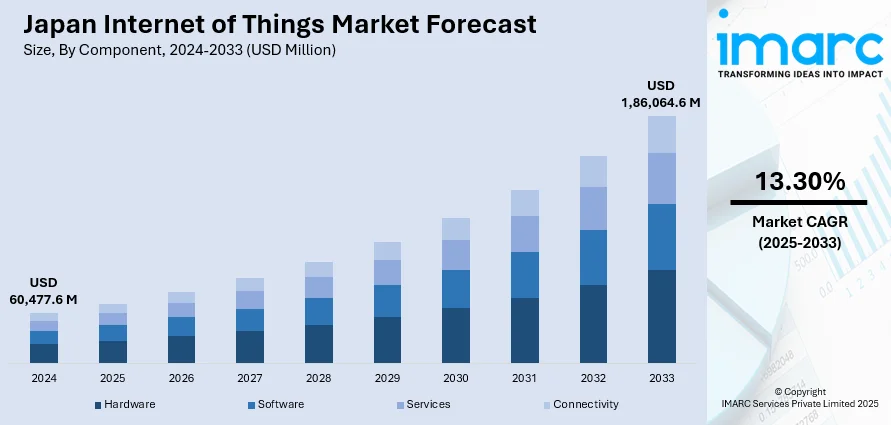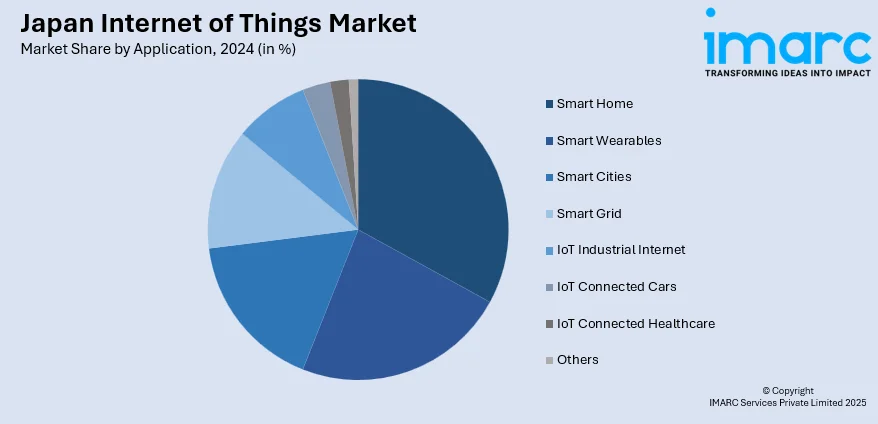
Japan Internet of Things Market Size, Share, Trends and Forecast by Component, Application, Vertical, and Region, 2025-2033
Japan Internet of Things Market Overview:
The Japan internet of things market size reached USD 60,477.6 Million in 2024. Looking forward, IMARC Group expects the market to reach USD 1,86,064.6 Million by 2033, exhibiting a growth rate (CAGR) of 13.30% during 2025-2033. The market is fueled by industrial automation, government strategies such as Society 5.0, and the fast pace of technological developments like 5G and AI penetration. An aging population escalating demand for telemedicine, while smart city initiatives spur IoT penetration in energy, transportation, and infrastructure, driving overall market expansion.
|
Report Attribute
|
Key Statistics
|
|---|---|
|
Base Year
|
2024 |
|
Forecast Years
|
2025-2033
|
|
Historical Years
|
2019-2024
|
| Market Size in 2024 | USD 60,477.6 Million |
| Market Forecast in 2033 | USD 1,86,064.6 Million |
| Market Growth Rate 2025-2033 | 13.30% |
Japan Internet of Things Market Trends:
Smart Manufacturing and Industrial IoT (IIoT) Growth
Japanese manufacturing industries are increasingly using Industrial Internet of Things (IIoT) technology to make processes more efficient and sustain competitiveness. The application of IoT-equipped sensors, robots, and artificial intelligence (AI) analytics-powered predictive maintenance, real-time monitoring, and rapid manufacturing enables quick reaction to market dynamics. This trend is most visible in areas such as Kanto and Kansai, where manufacturing centers are using IIoT to streamline production processes and minimize downtime. The encouragement of digital transformation efforts by the Japanese government, including Industry 4.0, also speeds up the implementation of IIoT solutions in industries such as automotive, energy, and manufacturing, in turn further contributing to the Japan internet of things market growth.

Smart Cities and Urban IoT Integration Emergence
Japan's emphasis on sustainable city growth has resulted in the spread of smart city projects throughout key cities such as Tokyo, Yokohama, and Fukuoka. The projects implement IoT technologies in order to advance urban life by optimizing infrastructure, public utilities, and quality of life in general. As an example, traffic management smart systems employ IoT sensors and data analytics to increase traffic efficiency and alleviate congestion. Equally, intelligent grids, efficient buildings, and cutting-edge waste management are being rolled out to produce greener and more efficient urban settings. Support by the government toward developing smart cities through investment and policy strategies is spurring IoT solutions, becoming one of the most highlighted Japan internet of things market share trends.
Convergence of 5G Connectivity and Edge Computing
Japan's 5G network rollout is transforming the world of IoT by offering ultra-low latency, high bandwidth, and reliability. Such increased connectivity enables real-time communication between devices to support sophisticated applications like autonomous cars, remote medical services, and industrial automation. Furthermore, edge computing adoption provides data processing closer to the point of origin, lowering latency and bandwidth consumption while providing intelligent decision-making without central cloud servers' dependence. These technologies are opening up new opportunities for IoT usage in different industries, promoting innovation and efficiency in the Japan internet of things market outlook.
Japan Internet of Things Market Segmentation:
IMARC Group provides an analysis of the key trends in each segment of the market, along with forecasts at the regional level for 2025-2033. Our report has categorized the market based on component, application, and vertical.
Component Insights:
- Hardware
- Software
- Services
- Connectivity
The report has provided a detailed breakup and analysis of the market based on the component. This includes hardware, software, services, and connectivity.
Application Insights:

- Smart Home
- Smart Wearables
- Smart Cities
- Smart Grid
- IoT Industrial Internet
- IoT Connected Cars
- IoT Connected Healthcare
- Others
A detailed breakup and analysis of the market based on the application has also been provided in the report. This includes smart home, smart wearables, smart cities, smart grid, IoT industrial internet, IoT connected cars, IoT connected healthcare, and others.
Vertical Insights:
- Healthcare
- Energy
- Public and Services
- Transportation
- Retail
- Individuals
- Others
A detailed breakup and analysis of the market based on the vertical has also been provided in the report. This includes healthcare, energy, public and services, transportation, retail, individuals, and others.
Regional Insights:
- Kanto Region
- Kansai/Kinki Region
- Central /Chubu Region
- Kyushu-Okinawa Region
- Tohoku Region
- Chugoku Region
- Hokkaido Region
- Shikoku Region
The report has also provided a comprehensive analysis of all the major regional markets, which include Kanto Region, Kansai/Kinki Region, Central /Chubu Region, Kyushu-Okinawa Region, Tohoku Region, Chugoku Region, Hokkaido Region, and Shikoku Region.
Competitive Landscape:
The market research report has also provided a comprehensive analysis of the competitive landscape. Competitive analysis such as market structure, key player positioning, top winning strategies, competitive dashboard, and company evaluation quadrant has been covered in the report. Also, detailed profiles of all major companies have been provided.
Japan Internet of Things Market News:
- In February 2024, Internet Initiative Japan announced the signing of a memorandum of understanding (MoU) with collaborators from Japan and Indonesia, concentrating on research and technology advancement to enhance science and technology in the IoT field in Indonesia. The partners in the agreement consist of Murata Manufacturing from Japan and in Indonesia, the Research Organization for Electronics and Informatics (OREI) under the National Research and Innovation Agency (BRIN), along with PT Agrisinar Global Indonesia (AGI), an IT firm that offers a traffic counting service in Indonesia. As per the agreement, the collaborators will engage in joint research and development centered around IoT, especially in domains such as transportation and map data, which includes examining information gathered from IoT devices and developing algorithms.
Japan Internet of Things Market Report Coverage:
| Report Features | Details |
|---|---|
| Base Year of the Analysis | 2024 |
| Historical Period | 2019-2024 |
| Forecast Period | 2025-2033 |
| Units | Million USD |
| Scope of the Report |
Exploration of Historical Trends and Market Outlook, Industry Catalysts and Challenges, Segment-Wise Historical and Future Market Assessment:
|
| Components Covered | Hardware, Software, Services, Connectivity |
| Applications Covered | Smart Home, Smart Wearables, Smart Cities, Smart Grid, IoT Industrial Internet, IoT Connected Cars, IoT Connected Healthcare, Others |
| Verticals Covered | Healthcare, Energy, Public and Services, Transportation, Retail, Individuals, Others |
| Regions Covered | Kanto Region, Kansai/Kinki Region, Central /Chubu Region, Kyushu-Okinawa Region, Tohoku Region, Chugoku Region, Hokkaido Region, Shikoku Region |
| Customization Scope | 10% Free Customization |
| Post-Sale Analyst Support | 10-12 Weeks |
| Delivery Format | PDF and Excel through Email (We can also provide the editable version of the report in PPT/Word format on special request) |
Key Questions Answered in This Report:
- How has the Japan internet of things market performed so far and how will it perform in the coming years?
- What is the breakup of the Japan internet of things market on the basis of component?
- What is the breakup of the Japan internet of things market on the basis of application?
- What is the breakup of the Japan internet of things market on the basis of vertical?
- What is the breakup of the Japan internet of things market on the basis of region?
- What are the various stages in the value chain of the Japan internet of things market?
- What are the key driving factors and challenges in the Japan internet of things market?
- What is the structure of the Japan internet of things market and who are the key players?
- What is the degree of competition in the Japan internet of things market?
Key Benefits for Stakeholders:
- IMARC’s industry report offers a comprehensive quantitative analysis of various market segments, historical and current market trends, market forecasts, and dynamics of the Japan internet of things market from 2019-2033.
- The research report provides the latest information on the market drivers, challenges, and opportunities in the Japan internet of things market.
- Porter's five forces analysis assist stakeholders in assessing the impact of new entrants, competitive rivalry, supplier power, buyer power, and the threat of substitution. It helps stakeholders to analyze the level of competition within the Japan internet of things industry and its attractiveness.
- Competitive landscape allows stakeholders to understand their competitive environment and provides an insight into the current positions of key players in the market.
Need more help?
- Speak to our experienced analysts for insights on the current market scenarios.
- Include additional segments and countries to customize the report as per your requirement.
- Gain an unparalleled competitive advantage in your domain by understanding how to utilize the report and positively impacting your operations and revenue.
- For further assistance, please connect with our analysts.
 Request Customization
Request Customization
 Speak to an Analyst
Speak to an Analyst
 Request Brochure
Request Brochure
 Inquire Before Buying
Inquire Before Buying




.webp)




.webp)












